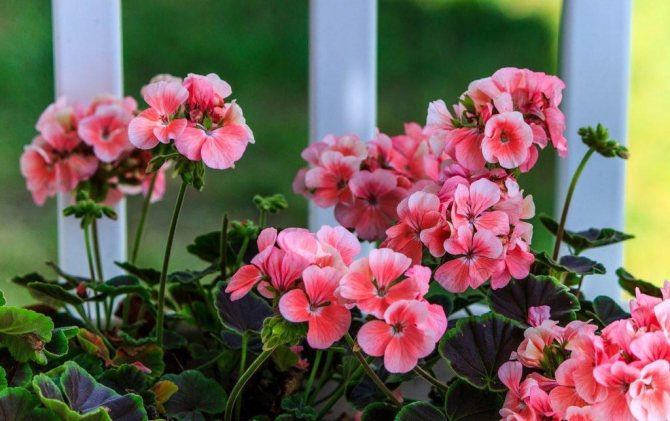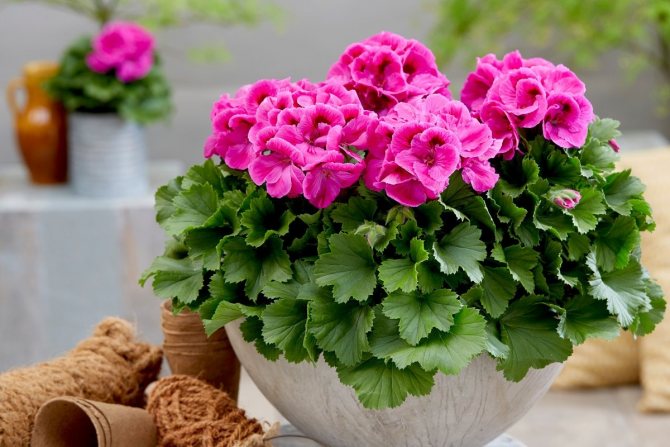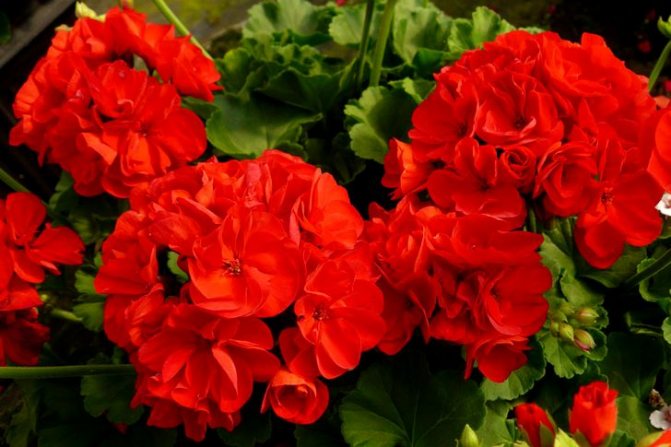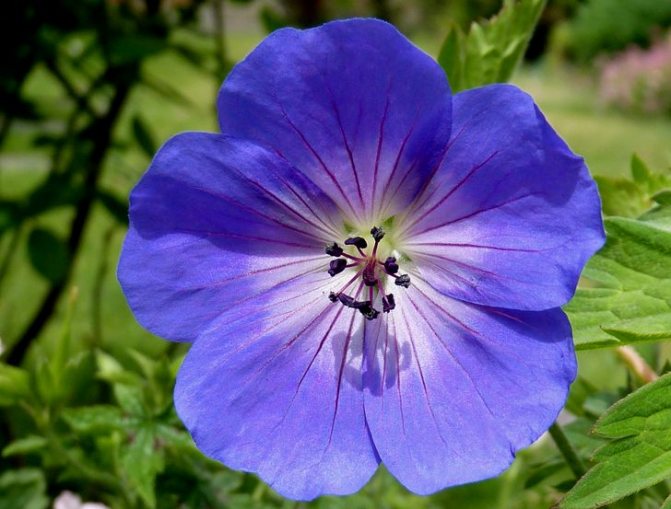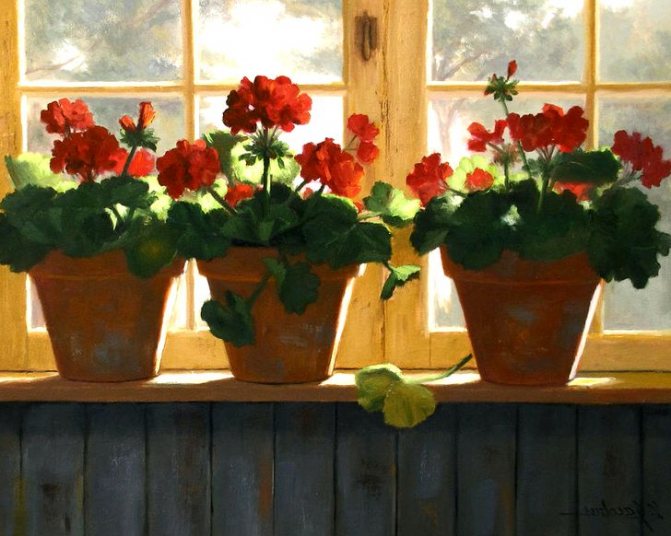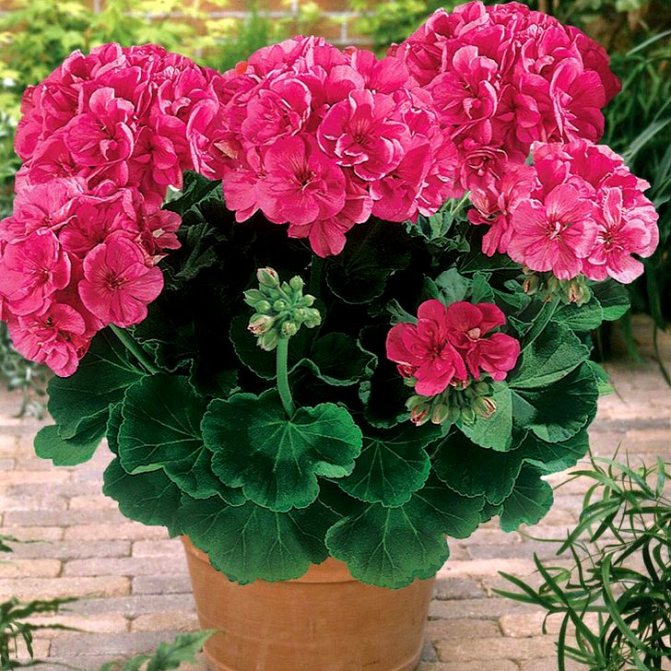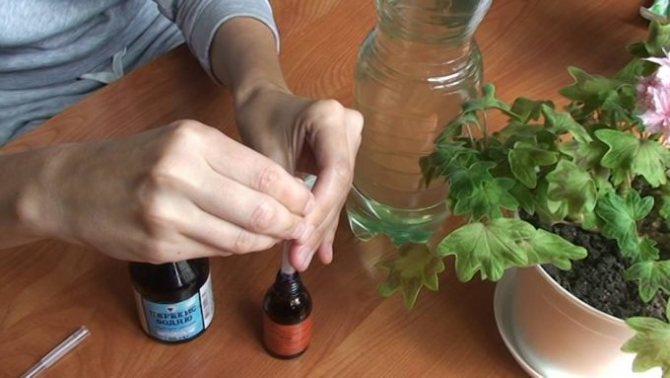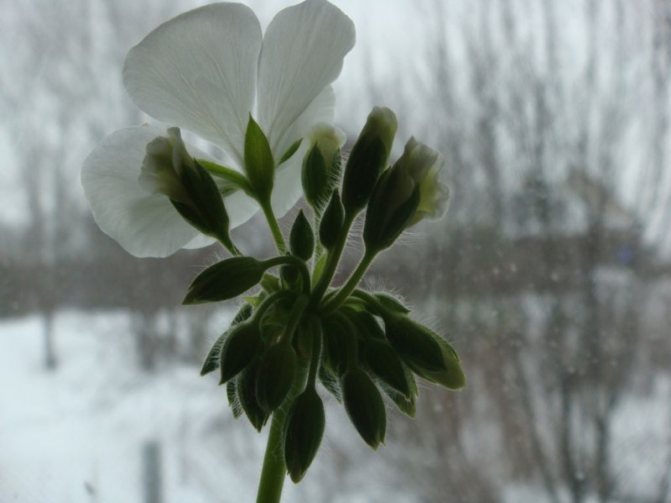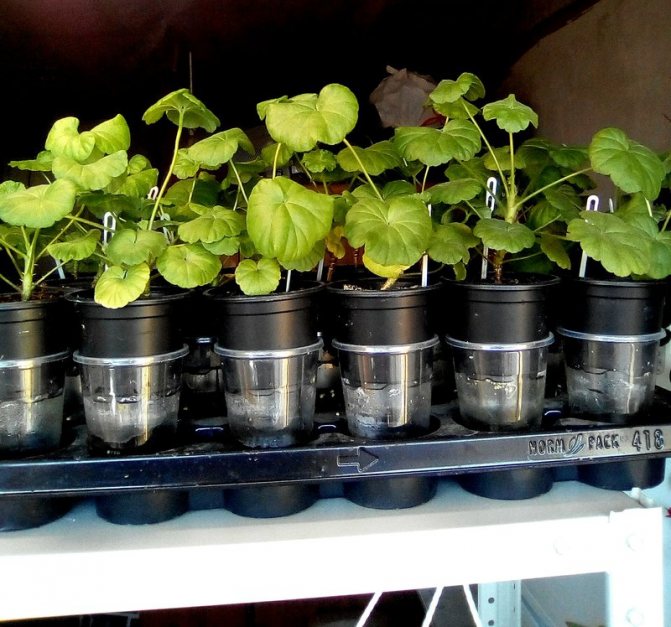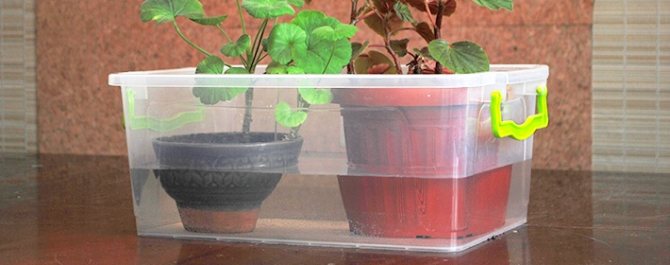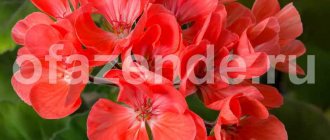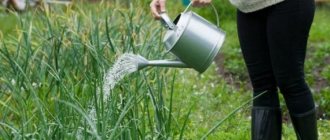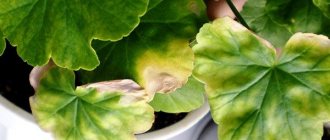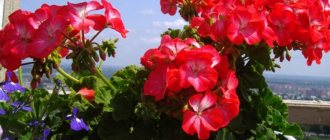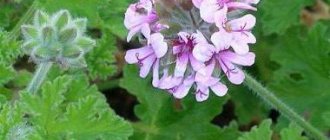Does the geranium flower love water?
The culture needs a moderate amount of fluid. Excess moisture provokes root rot. This negatively affects the state of the flower and manifests itself in the form of yellowing of the leaves, the formation of water pads, and the wilting of all components of the culture. In this case, the foliage is covered with gray mold.
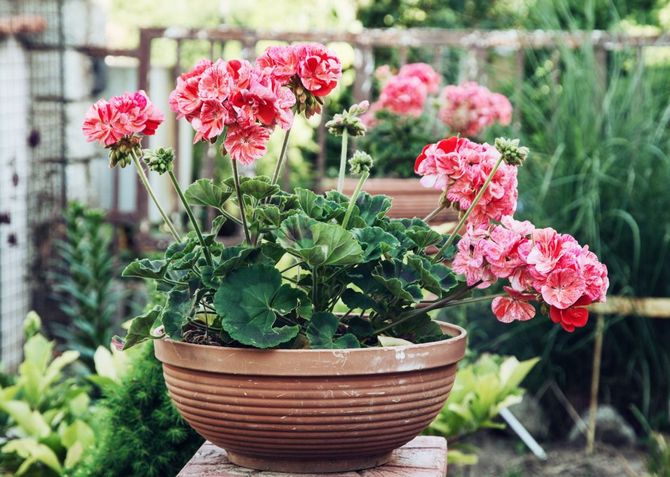
Geranium has a beautiful and lush bloom
Important! If the stem of the culture rots, this indicates the irreversibility of the process and rotting of the root system. Such a plant is likely to die.
The culture can withstand moisture deficit more easily. However, prolonged lack of watering will dry out the edges of the leaves. As a result, dry spots will appear on them. In such a situation, the culture will shed its foliage and will not be able to fully bloom.
Geranium leaves turn yellow
Yellowing of the leaf plates at the edges indicates insufficient watering, a lack of moisture is the main cause of the problem. If the color change accompanies the general sluggish state of the flower, then the amount of liquid is reduced.


Geranium, appearance
Why do geranium leaves turn yellow? Lack of lighting in the room leads to yellowing of the lower leaves on the plant.


Yellowing foliage in geranium
To avoid this problem, you need to monitor the watering and the size of the geranium pot. Narrow containers do not allow the roots to fully develop, which is the reason for the death of some areas of the culture, they may dry out at first.
An important point. Post-transplant yellowing is a common side effect. Such foliage is simply cut off, and the plant continues its normal development.
Geranium leaves turn yellow and dry, what should I do? There are quite a few reasons for this phenomenon, so it is worth considering in detail some of them.
Incorrect temperature conditions
The ideal indicator for indoor geranium is + 20 ° C. Increasing the parameter leads to a change in the color of the sheet plates. Most often, this can be observed in the winter with strong heating of the air from the central heating batteries.
Use of chemicals
Drying and yellowing of foliage occurs if chemicals, for example, preparations for the destruction of weeds, have got on pelargonium. In addition, the flower exhibits increased sensitivity to hygienic and cosmetic products: these are air fresheners, hair sprays, etc.
The presence of drafts
Most indoor plants are placed on windowsills, with regular ventilation, certain problems arise. Geranium leaves turn yellow, what should I do? In this case, you need to choose a place where drafts will not harm the pelargonium.
Is it possible to spray geranium
What water to water indoor flowers
Novice growers are often interested in: is it possible to spray a geranium flower? The foliage of the plant does not require additional moisture. The culture easily tolerates dry air, since it accumulates water in the cells when watering the roots.
Spraying foliage is undesirable. When watering a flower, it is important to control so that water does not fall on the leaves. Spraying will only harm the plant.


Spraying flower leaves is not recommended
Geranium leaves turn red
Phlox lower leaves turn yellow: what to do
Reddening of the leaf plates indicates that mistakes were made in the care of the culture. The reasons can be different: from violation of agrotechnical measures to incorrect content. To save a flower, it is necessary not only to respond to the problem in a timely manner, but also to treat the shrub.
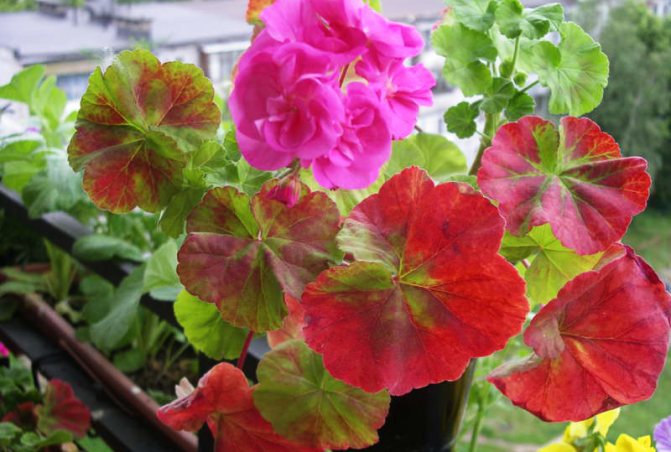

Geranium leaves turn red
There may be several reasons:
- Low room temperatures. With stable readings of +18 ° C and below, the plant begins to respond to conditions that are unsuitable for it, namely, reddening of the leaf plates from the tips, then the color of the entire leaf changes. The temperature must be adjusted as soon as possible, until the pelargonium has shed all the leaves;
- Diseases of a fungal or bacterial nature. Plants exposed to excessive watering and standing in a cool room are at risk. This environment is very popular with various spores and bacteria;
- Lack of nutrients. The lack of fertilizing with magnesium and nitrogen leads to the fact that geranium leaves turn red;
- Fertilizing in large quantities. Leaf plates turn red even if the culture receives too much nitrogen;
- If geranium leaves turn red, the reason is the intensity of the sun's rays. Pelargonium is a light-loving plant, but under prolonged exposure to the sun, it begins to burn not only the foliage, but also the stem. They appear as red spots.
Water requirements
Answering the question of how to water geraniums, one cannot fail to mention the quality of the water. The flower needs soft and clean water. It should be at room temperature. Florists often wonder if tap water can be used for irrigation. It all depends on its quality.
How to water an orchid correctly and how often
If the liquid is soft enough, does not contain harmful components and does not have an unpleasant odor, it is permissible to use it for watering. Preliminary should be defended in a separate container. If low-quality water flows from the tap, you should use a purifying filter and boil the liquid.
Important! Before use, the water must be defended. This does not depend on what kind of liquid is used, purified or tap.
It is not worth using cold water to moisten the soil. Geranium is a tropical flower. Therefore, too cold a liquid provokes root rot and the development of diseases.
Do not water the bushes with hard water. Its use has a negative impact on the development of culture. To understand that the stiffness exceeds the norm, it is worth assessing the condition of the soil. Due to hard water, salt deposits appear on the soil surface, and the foliage acquires a less saturated color.


Geranium needs to be watered with settled water
Why do geranium leaves dry
Why do rhododendron leaves turn yellow and what to do
Another problem that a geranium owner may face is the drying out of the leaf blades. There are several reasons for this condition in a plant:
- insufficient illumination;
- excessive or insufficient watering;
- sunburn;
- unsuitable temperature regime;
- diseases of pelargonium of fungal nature;
- the appearance of pests;
- small pot.
Some of the reasons have already been discussed above, therefore, the options that have not yet been presented will be considered in more detail.
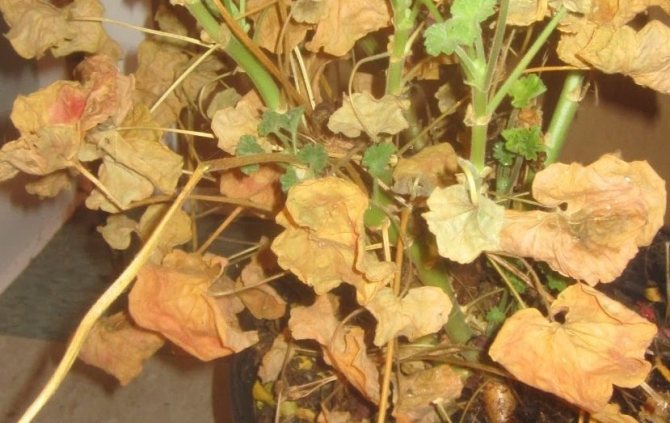

Leaves dry
The lack of light is expressed by the gradual yellowing and drying of the leaves located below the plant. The stem part begins to stretch, the flowering phase is either very rare or absent at all. It is easy to correct the situation by rearranging the pot to a more suitable place, closer to the light source, or installing a phytolamp.
Worth knowing! Tearing off yellow leaves is not recommended. In order for the flower to begin to grow in width, the top of its head is pinched.
The appearance of pests is accompanied by the formation of small yellow dots. In some cases, the shoots are covered with sticky bloom or cobwebs. As the points grow, the leaf plates begin to dry out. It is necessary to determine who is harming the plant and get rid of the parasite as soon as possible.
The tightness is indicated by the state of the leaves: at first they may turn yellow, then dry and fall off. In addition, the root system begins to show through the drainage hole of the pot. The best way out of the situation is a culture transplant.
In addition, you need to pay attention to how the foliage dries:
- the defeat affects the leaf plates at the edges - insufficient watering;
- the plant itself begins to dry out - a disease of fungal origin.
Bordeaux liquid 5% will help get rid of the fungus. At the same time, the culture is treated with Fitosporin twice with a week break.
Watering frequency
Many people are interested in how often geraniums should be watered. Proper soil moisture provides abundant flowering and normal development of the bush. Excess moisture and its stagnation in the pot provokes rotting of the root system. In such a situation, there is a risk of problems with oxygen supply.
How to water zamioculcas correctly so as not to ruin
To prevent such problems, you will need a drainage layer and holes in the bottom of the pot to drain excess liquid. For an even distribution of moisture, a container with a narrow neck is required. This method helps prevent soil flooding and plant death.
During the growing season, the flower grows actively. In this case, the number of waterings should be increased. It is necessary to water the soil as its top layer dries up by 1 cm.As a rule, geranium is watered every 3 days.
During the period of active development and when the temperature in the house rises, the frequency of watering should be increased. In this case, it is recommended to moisten the soil with an interval of 1-2 days.
Important! In winter, the plant is dormant. In this case, the number of waterings is reduced to 1 time per week.


It is important to observe the frequency of watering
How to choose a pot for the best watering benefits?
Geraniums are usually grown in small boxes or pots. The size of the pots must match the dimensions of the root system. The pot should be medium in size so that the volume of water that enters it is optimal. In small pots, pelargonium blooms much better, while the flowers have a more graceful and catchy shade. And in large pots, the bush itself develops excellently, but the flowers look worse.
Large pots are used only when there is not enough space for the bush in the container. There are clay and plastic pots, but plastic pots do not allow the plant to dry out normally, which entails rotting of the roots. The optimal size (diameter) of the pot for effective watering is 20-25 centimeters, the height is 12-15.
Ways to water geraniums at home
If geraniums are grown at home, watering is carried out in different ways. Each of them has certain characteristics.
Wick irrigation
This method is simple and reliable. It helps save time. However, violation of the algorithm can lead to negative consequences for the flower.
The advantages of the technique include the following:
- avoids the need for manual watering for 2-3 weeks;
- the flower can receive as much water as required;
- the size and number of buds increase;
- during the growing season, the plant suffers less from temperature fluctuations;
- young bushes are actively developing;
- the number of rotting stems is reduced.
Wick irrigation is simple. When transplanting a flower in the bottom of the container, it is worth making holes and threading a string through them. A sufficient amount of peat must be added to the soil, which allows moisture to pass through well.
For watering in a container installed next to the plant, you should collect warm, settled water and lower the wick into it. It is important that the lace is synthetic.This will help prevent it from rotting in the ground.
Through the pallet
This method is considered simple and affordable. It helps to avoid waterlogging of the soil. A large basin can be used as a pallet. The advantages of the method include the following:
- the risk of waterlogging of the soil is minimal;
- the roots will not rot;
- the soil is better saturated with oxygen.
How to water pelargonium at home? For this, the pot is placed on a tray with water. In this case, you only need to use one plant. This helps to minimize the chances of infections spreading.
Pour enough water into the pan so that it covers a quarter of the pot. The bush must be left in the container for half an hour. When the soil darkens, the water must be drained.
Important! It is worth watering with a pallet as the soil dries up by 1-1.5 cm.You can check the condition of the earth with your finger.
Humidification from above
This method is suitable for all tropical crops. In this case, it is important to moisten only the soil. Water the soil from a watering can. This should be done carefully so as not to accidentally spray the leaves.
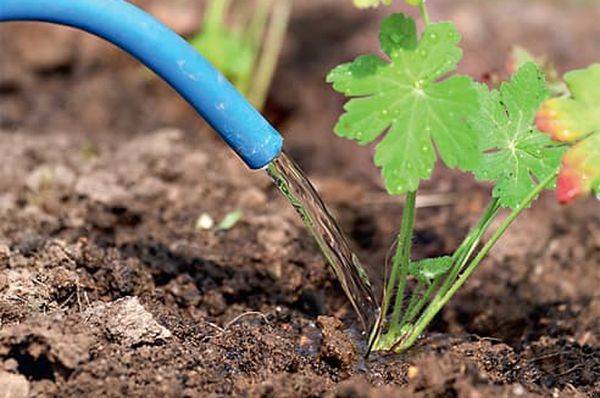

Top geraniums are poured from a watering can
Geranium - signs and superstitions
Not so long ago, geranium, along with ficus, was a very common flower. She stood on almost every windowsill, in every room. Now, with the appearance of a large number of exotic flowers, it is undeservedly forgotten. After all, many positive signs are associated with it:
- Raising money. If unmarried girls carry a bag of dry geranium leaves with them, they have a chance to quickly attract the attention of the person they like;
- Protection against negative impact. Geranium oil has a protective property, and if you carry it with you, you can protect your biofield from negativity.
- Calming and relieving stress. The specific smell relieves tension and irritability, normalizes the human nervous system.
According to the signs of our ancestors, the pelargonium flower is able not only to serve as an ornament, but also to have other effects on people:
- evoke sympathy of the opposite sex;
- protect home and family from evil and gossip;
- help to increase financial well-being;
- extinguish quarrels and conflicts in the family;
- promotes perseverance and better memorization of knowledge;
- reveals abilities and helps to realize them.
Geranium white
Signs associate the flowering of white pelargonium with pregnancy and motherhood. If a married couple suffers from infertility and the inability to have children, then it is recommended to put a flower with white buds near the matrimonial bed.
For lonely people, this plant promises a quick meeting of its half. It may even be possible to create a strong marriage with this person.


The white geranium presented for a wedding will not only contribute to the early acquisition of children, but also help build healthy family relationships.
Also, a white flower is indicated for insomnia and increased excitability. It helps put the nervous system in order.
Geranium red
Fire-colored pelargonium protects against scandals and abuse. The smell of this flower pacifies, allows you to extinguish the heat of passions.
Red geranium helps girls get married as soon as possible, and married women keep their youth and beauty longer. The red flowers of homemade pelargonium symbolize a strong love relationship. Therefore, in a family home, such a flower will not be superfluous at all.


This flower attracts monetary prosperity to the house. And if you place an azalea next to a red geranium, you can prevent material problems in the family.
Geranium pink
Pink geranium improves family relationships, protects against unwanted interference from rivals or rivals.
The pink flower helps to unleash creativity, to successfully realize it, as well as to successfully start a new business. This can apply to both starting your own business and building a new home.
Geranium lilac
Pelargonium of such a rare color normalizes relations between people. It is recommended to have it for someone who wants to find friends. The lush bloom of such a flower predicts an early pleasant acquaintance, which can develop into a strong friendship.
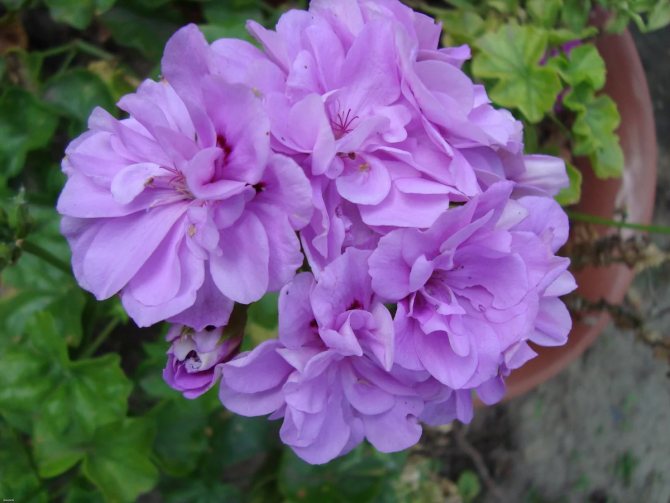

Watering in combination with top dressing
From spring to the first half of summer, geranium needs additional feeding. To do this, you can use different drugs. Moreover, the procedure should be combined with watering.
The following fertilizers are required for geraniums:
- Iodine. Add 1 drop of the product to 1 liter of water. First, the plant needs to be watered with plain water, then add 40-50 ml of solution.
- Ammonia. To make a useful remedy, dissolve 1 small spoonful of alcohol in 1 liter of water.
- Hydrogen peroxide. For 1 liter of water, you should take 2 large spoons of the substance. You can also use the Epin solution.
- Succinic acid. Use 1 tablet for 1 liter of water. The bush is watered at the root.
Pelargonium is a pleasant plant. Different types of pelargonium can boast beautiful leafy attire or pleasant flowers. For a long time, pelargonium was confused with geraniums. Although these two genera are part of the same geranium family, there are differences between them. Unlike geraniums, pelargonium is thermophilic. Therefore, in the climate of Russia, pelargonium can often be seen in light and warm rooms than in the garden, and we call it “geranium” with warmth and affection.


Cape of Good Hope
Europeans learned about pelargonium in 1600, when the ships of the Dutch East Indian charter company, which is actively trading with the countries of the Far East, returned to Holland. On the way home, the ships stopped at the Cape of Good Hope in South Africa. Here the sailors replenished their supplies of water and food. Along the way, the search for new plants was undertaken. In those days, people were interested not so much in the beauty of plants as in their pharmacological properties: with the help of plants it was possible to treat certain diseases. A decoction of the tubers of one of the plants found was useful for the treatment of dysentery, and the expedition delivered the seeds of this plant to the Leiden Botanical Garden in Holland.
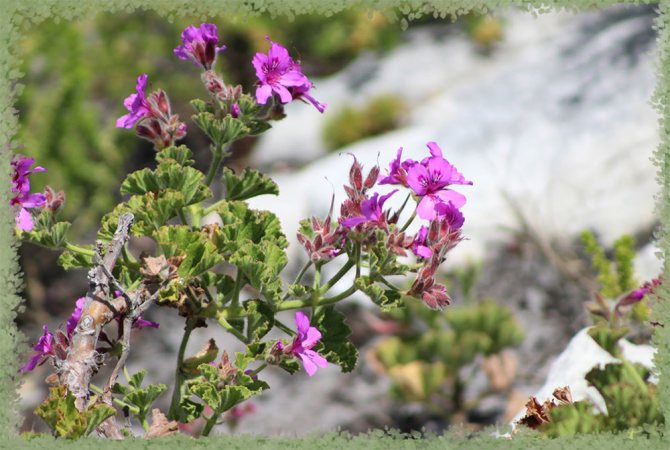

Pelargonium in the National Park in Namibia
Thirty years have passed. English gardener John Tradescant the Elder received several seeds of the same plant from his friend Rene Morin from Paris. We know from records in the British Museum that Tradescant the Elder raised three specimens of this plant; he called it Sweet Indian Storksbill. It was a plant with tuberous roots and heavily dissected leaves resembling carrot leaves. The long pubescent pedicels also had leaves, but smaller. Small, star-like flowers appeared simultaneously in an amount of 6 to 20 pieces. However, the main feature of the plant was a fragrant nutmeg aroma, which intensified at night and almost disappeared during the day.
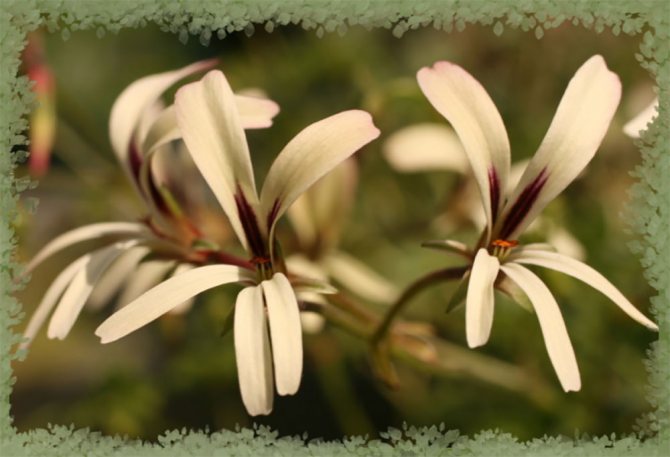

Sad geranium later renamed to Sad Pelargonium
In 1753, the Swedish scientist Karl Linnaeus identified the plant as described by Tradescant as Geranium triste. Linnaeus had at his disposal about 20 species of similar plants, among which was the sad geranium, and Linnaeus combined them all into one genus Geranium (Geranium). The plant was also called "Indian geranium", because at that time there was still no clear geographical idea of our planet, its continents and countries. That is why all the plants that were brought from the East were called "Indian". In fact, India had nothing to do with the new plant. About 20 species originate from East Africa, a certain number were found on the South Atlantic island of Saint Helena, on the island of Madagascar, they are also found in Australia, New Zealand and Tasmania, as well as in Asia - Turkey, Iraq, but the vast majority of species (219 of 250 known) were found in the Republic of South Africa, which can rightfully be called the birthplace of the "thermophilic geranium".As the European colonialists moved deeper into Africa, plant hunters explored more and more protected areas. The number of new species of geraniums has also increased.
Over time, it became apparent that there are significant differences between plants from the genus geranium. It was found that representatives of the savannahs of South Africa love warmth and sun, easily tolerate a lack of moisture and do not like its excess. On the contrary, the inhabitants of the middle lane prefer coolness, they normally tolerate excess moisture (there is even a species of marsh geranium) or a lack of it, they are resistant to frost (northern geraniums did not suffer even in the winter of 1978/79, when the temperature in Moscow dropped below -40 ° C) ...
Differences were also revealed in the physical structure: in flowers of thermophilic species, the petals are grouped into two upper and three lower ones. The top two petals are usually larger and brighter in color. The flower petals of the northern sisters have the same shape and are equidistant from each other.
By 1738, the contradictions became so obvious that Johannes Burman (1707-1780) introduced a different name for some African species - pelargonium. Translated from the Greek ‘pelargos’ means stork. The famous botanist Caspar Commeline liked the name and introduced it into scientific terminology. In 1789, the French botanist Charles L'Héritier finally divided the plants into two groups: Geranium (Geranium) and Pelargonium (Pelargonium), which, nevertheless, remained in the same family - the geranium family.

